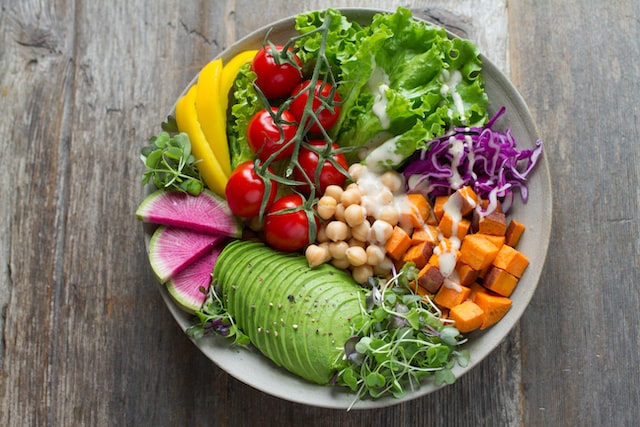
Eating healthy involves making balanced and nutritious choices in your diet. This means incorporating a variety of fruits, vegetables, whole grains, and lean proteins into your meals and snacks. It is also important to limit your intake of processed and sugary foods, as well as unhealthy fats such as trans fats and saturated fats. To ensure you are getting all the nutrients your body needs, it is a good idea to pay attention to serving sizes and to vary your meals and snacks. It can also be helpful to plan ahead and prepare healthy meals and snacks in advance so that you have healthy options readily available when you are short on time or hungry. Finally, it is important to stay hydrated by drinking plenty of water throughout the day.
Benefits of Meal Prepping
Meal prep, or preparing meals in advance, can have a number of benefits. One of the main benefits is that it can help you save time and effort during the week. When you have already prepared and portioned out your meals, you don’t have to spend as much time cooking and cleaning up. This can be especially helpful if you are short on time or have a busy schedule. Additionally, meal prep can help you save money by reducing the need for takeout or dining out. It can also be a good way to ensure that you are eating healthy, balanced meals, as you can plan and prepare your meals with specific nutrients in mind. Finally, you can use meal prep for weight loss. It can help you maintain a healthy weight, as you can control the ingredients and portion sizes of your meals.
Meal prepping can help you improve your kitchen skills and become more confident while cooking. It is a great opportunity to try new recipes and techniques. Not only will you learn new skills, but you will also be able to enjoy the delicious meals you create. By regularly preparing meals, you can gradually build up your knowledge and expertise in the kitchen.
Meal Prep Ideas
Here are some tips for easy meal prep:
Plan ahead: Determine what you want to make for the week and make a grocery list. This will help you save time at the grocery store and ensure that you have all the ingredients you need.
- Use batch cooking techniques: Make large batches of grains, proteins, and vegetables that can be used in multiple meals throughout the week. This saves time and allows for more variety in your meals.
- Prep your ingredients: Wash and chop your fruits and vegetables in advance, and store them in the fridge or freezer until you are ready to use them. This will save time during the actual meal prep process.
- Use a slow cooker: A slow cooker is a great tool for meal prep because it allows you to set it and forget it. You can throw all your ingredients in the slow cooker in the morning, and come home to a ready-to-eat meal in the evening.
By following these tips, you can streamline your meal prep process and make it easier to eat healthy throughout the week.
Meal Prep Containers
There are a variety of meal prep containers available on the market, each with its own unique features and benefits. Some common types of meal prep containers include:
- Glass containers: Glass containers are a popular choice because they are microwave-safe, dishwasher-safe, and generally have a longer lifespan than plastic containers. They are also environmentally friendly, as they can be recycled or reused.
- Plastic containers: Plastic containers are lightweight, easy to find, and often come in a variety of sizes and shapes. However, they may not be as durable as glass containers and are not as environmentally friendly.
- Stainless steel containers: Stainless steel containers are a good choice if you want a more durable and long-lasting option. They are also resistant to staining and do not retain odors. However, they may be more expensive than other types of containers.
Ultimately, the best meal prep container for you will depend on your personal preferences and needs. Consider factors such as durability, cost, environmental impact, and convenience when choosing the right containers for your meal prep needs.
Lunch Ideas
Here are some healthy lunch ideas:
Turkey and avocado wrap: Spread mashed avocado on a whole wheat tortilla, then top with sliced turkey, lettuce, tomato, and a drizzle of balsamic vinegar.
Grilled chicken and vegetable skewers: Grill chicken breasts and your favorite vegetables (such as bell peppers, onions, and zucchini) on skewers. Serve with a side of quinoa or brown rice.
Quinoa and black bean salad: Mix cooked quinoa with black beans, cherry tomatoes, diced cucumber, and a vinaigrette dressing. Top with crumbled feta cheese and a handful of baby spinach.
Hummus and vegetable wrap: Spread hummus on a whole wheat tortilla, then top with sliced bell peppers, cucumber, and carrot sticks. Roll up the tortilla and slice it into bite-size pieces.
Remember to vary your lunches to ensure you are getting a wide range of nutrients. You can also add a serving of fruit or a handful of nuts as a healthy snack to round out your meal.
Hey welcome to my blog . I am a modern women who love to share any tips on lifestyle, health, travel. Hope you join me in this journey!

Speak Your Mind